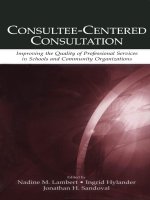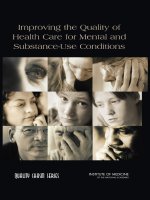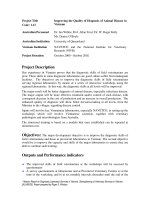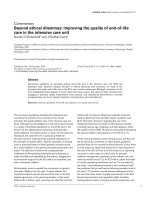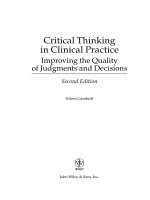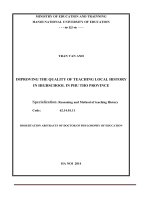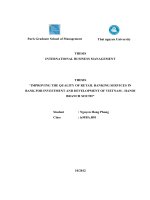Critical Thinking in Clinical Practice Improving the Quality of Judgments and Decisions pdf
Bạn đang xem bản rút gọn của tài liệu. Xem và tải ngay bản đầy đủ của tài liệu tại đây (2.89 MB, 649 trang )
Critical Thinking
in Clinical Practice
Improving the Quality
of Judgments and Decisions
Second Edition
Eileen Gambrill
John Wiley & Sons, Inc.Critical Thinking
in Clinical PracticeCritical Thinking
in Clinical Practice
Improving the Quality
of Judgments and Decisions
Second Edition
Eileen Gambrill
John Wiley & Sons, Inc.
This book is printed on acid-free paper. o
Copyright © 2005 by John Wiley & Sons. All rights reserved.
Published by John Wiley & Sons, Inc., Hoboken, New Jersey.
Published simultaneously in Canada.
No part of this publication may be reproduced, stored in a retrieval system, or transmitted in any form
or by any means, electronic, mechanical, photocopying, recording, scanning, or otherwise, except as
permitted under Section 107 or 108 of the 1976 United States Copyright Act, without either the prior
written permission of the Publisher, or authorization through payment of the appropriate per-copy fee to
the Copyright Clearance Center, Inc., 222 Rosewood Drive, Danvers, MA 01923, (978) 750-8400, fax (978)
646-8600, or on the web at www.copyright.com. Requests to the Publisher for permission should be
addressed to the Permissions Department, John Wiley & Sons, Inc., 111 River Street, Hoboken, NJ 07030,
(201) 748-6011, fax (201) 748-6008. e-mail:
Limit of Liability/Disclaimer of Warranty: While the publisher and author have used their best efforts
in preparing this book, they make no representations or warranties with respect to the accuracy or
completeness of the contents of this book and specifically disclaim any implied warranties of
merchantability or fitness for a particular purpose. No warranty may be created or extended by sales
representatives or written sales materials. The advice and strategies contained herein may not be suitable
for your situation. You should consult with a professional where appropriate. Neither the publisher nor
author shall be liable for any loss of profit or any other commercial damages, including but not limited to
special, incidental, consequential, or other damages.
This publication is designed to provide accurate and authoritative information in regard to the subject
matter covered. It is sold with the understanding that the publisher is not engaged in rendering
professional services. If legal, accounting, medical, psychological or any other expert assistance is
required, the services of a competent professional person should be sought.
Designations used by companies to distinguish their products are often claimed as trademarks. In all
instances where John Wiley & Sons, Inc. is aware of a claim, the product names appear in initial capital or
all capital letters. Readers, however, should contact the appropriate companies for more complete
information regarding trademarks and registration.
For general information on our other products and services please contact our Customer Care
Department within the United States at (800) 762-2974, outside the United States at (317) 572-3993 or fax
(317) 572-4002.
Wiley also publishes its books in a variety of electronic formats. Some content that appears in print may
not be available in electronic books. For more information about Wiley products, visit our web site at
www.wiley.com
ISBN-13: 978-0-471-471189
ISBN-10: 0-471-471186
Printed in the United States of America.
10987654321
In memory of all the
Daisy Andersons
Preface vii
Part I Lay of the Land
l The Need for Critical Thinking in Clinical Practice 3
2 Sources of Influence on Decisions That Clinicians Make 30
3Reasons and Reasoning: The Heart of Making Decisions 58
4 Different Views of Knowledge and How to Get It: Exploring
Your Personal Epistemology 85
Part II Common Sources of Error
5 The Influence of Language and Persuasion Strategies 123
6 Formal and Informal Fallacies: Mistakes in Thinking and
How to Avoid Them 144
7 Classification, Pseudoauthority, and Focusing on Pathology 165
Part III Decision Aids
8 Content and Procedural Knowledge 189
9Taking Advantage of Research on Judgment, Problem Solving,
and Decision Making 218
10 Evidence-Based Practice: A Philosophy and Process for Thinking
Ethically and Critically about Decisions 253
11 Posing Questions and Searching for Answers 286
12 Critical Appraisal of Practice-Related Research: The Need
for Skepticism 323
Part IV Applying Critical Thinking Skills to Clinical Decisions
13 Making Decisions About Data Collection 363
14 Discovering Causes of Clients’ Problems: Common Biases 395
vii
15 Predictions about Clients and Treatment Effectiveness:
Improving the Odds 438
16 Enhancing the Quality of Case Conferences, Team Meetings,
and Organizational Culture 476
Part V The Future
17 Overcoming Personal Obstacles to Critical Thinking 499
18 Maintaining Critical Thinking Skills 524
References 541
Author Index 603
Subject Index 619
About the Author 631
viii Contents
Preface
C
ritical Thinking in Clinical Practice is for clinicians who want to
think more clearly about the decisions they make and the context in
which they make them. This second edition describes the exciting re-
lated developments in evidence-based practice (EBP) and policy and updates
content as needed throughout. This book will be of value to all professionals
who offer services to clients, including psychologists, psychiatrists, social
workers, and counselors. Clinical practice is an uncertain enterprise. Much re-
mains unknown about what works best with which client toward what aim,
and wide variations exist in how clinicians carry out their practice. Indeed, the
very criteria that should be used to evaluate outcomes are in dispute. Mistakes
are inevitable, even in the best of circumstances. However, even in uncertain
areas such as clinical practice, some decisions are better than others. The per-
centage of those that are better can be increased by avoiding common sources
of error.
The spirit in which this book is written is illustrated by the author of Straight
and Crooked Thinking: Thirty-Eight Dishonest Tricks of Debate (Thouless, 1974).
The purpose of learning about sources of error is to enhance critical thinking
skills, to learn to recognize errors and acquire strategies for minimizing avoid-
able mistakes. The emphasis here is on offering readers decision-making tools
(some have been referred to as “mind tools”; Gigerenzer, 2002a) that can im-
prove the accuracy of clinical judgments and related decisions. Surprisingly
little attention is devoted in professional training programs to many sources of
error that can lead clinicians astray. For example, little attention is given to in-
formal fallacies that may result in questionable decisions, such as relying on
tradition or what is popular to select practices and policies. Clinical decision
making is approached as a challenging process that can be improved by ac-
quiring skills integral to evidence-based practice, such as posing well-formed
questions that guide an efficient, effective search for practice- and policy-
related research. Beliefs, attitudes, and interpersonal skills that influence the
effectiveness with which content and procedural knowledge are used are re-
viewed. Some clinicians view clinical practice as an art, rejecting as irrelevant
related research. However, research findings are available in many areas that
can be put to good use, both at the individual level of practice and when
ix
making policy decisions. Critical thinking and evidence-based practice are
closely related; both reject authority as a guide (such as someone’s status), both
emphasize the importance of honoring ethical obligations, and both involve a
spirit of inquiry.
DEVELOPMENT OF THIS BOOK
A number of influences led to the writing of the first edition of this book.
One was the prevalence of common errors in thinking among clinicians. Ex-
amples include making decisions based on small biased samples, not recog-
nizing pseudoexplanations, and having a false sense of accuracy in predicting
future events. Another was puzzlement about the success of colleagues who
use weak rather than strong strategies when trying to influence others: Ex-
amples include using straw person arguments, misrepresenting positions,
and begging the question. A third was the discovery of books such as Straight
and Crooked Thinking (Thouless, 1974)—a well-written book describing a range
of common errors as well as remedies. A fourth influence was research con-
cerning human judgment and decision making that has been pulled together
in sources such as Human Inference (Nisbett & Ross, 1980) and Judgment and
Choice (Hogarth, 1980, 1987). Books such as The Protection of Children by Ding-
wall and his colleagues (Dingwall, Eekelaar, & Murray, 1983) that describe
decision-making processes in case conferences provided a supplement to
studies of clinical decision making by individuals. Research and theory in the
area of teaching people how to think more critically were also of value.
W
HAT
’
S
N
EW AND
W
HAT
’
S
N
OT
O
VER THE
P
AST
15 Y
EARS
The past years since the publication of the first edition are a fascinating mix
of progress and challenges. These are described in this book. Progress and in-
creases in critical thinking in clinical practice include the invention of the sys-
tematic review and the process and philosophy of evidence-based practice
and policy in medicine and health care and its spread to other professions
(Gambrill, 2006; Gibbs, 2003; Gray, 2001a; Sackett, Straus, Richardson, Rosen-
berg, & Haynes, 2000). There has been greater attention to pseudoscience and
fads in the helping professions (Jacobson, Foxx, & Mulick, 2005; Lilienfeld,
Lynn, & Lohr, 2003), to human service propaganda (Gibbs & Gambrill, 1999),
to harming in the name of helping (McCord, 2003; Sharpe & Faden, 1998), to
flaws in research related to clinical practice (Altman, 2002; Gray, 1997, 2001b),
to fraud in related industries such as “Big Pharma” (Angell, 2004; Kassirer,
2005) and to ethical obligations of professionals, for example, to involve clients
as informed participants (Edwards & Elwyn, 2001). All of these developments
promise to enhance the quality of services provided to clients.
On the other hand, propaganda in the human service professions grows by
leaps and bounds, including its distribution via advertisements on our televi-
sion screens (e.g., Moynihan, Heath, Henry, & Gøtzsche, 2002). The Internet is
x Preface
both a source of accurate information and bogus claims and quackery. It is per-
haps this very growth and the absurdity of some of the claims and the revela-
tions of fraud and the play of special interests that do not match those of clients
(e.g., harming in the name of helping) that has resulted in the greater attention
to propaganda, harm, and fraud in the helping professions—including the
creation of ways to decrease them. When parents start to be threatened with
being reported to child protection services because they refuse to place their
child on Ritalin, some counter-pressure is bound to happen. And when any-
thing that sounds good comes along such as evidence-based practice, there
will be those who simply apply the new label to old practices that share none
of the characteristics of evidence-based practice (Gambrill, 2003a). Who will
know? Who will look? Who will care?
OVERVIEW OF THE CHAPTERS
Chapter 1 describes the vital role of decision making in clinical practice,
kinds of errors that may occur and their sources, as well as the importance of
thinking critically about decisions. Hallmarks of critical thinking are re-
viewed, including related values, attitudes, and styles, and its integral associ-
ation with evidence-based practice is emphasized. Barriers to making sound
decisions are discussed, including social, economic, and political influences
on the helping professions. The role of emotions, goals, and information-
processing strategies in making decisions is highlighted, and ways in which
these may lead to errors noted; for example, discounting conflicting informa-
tion in exploring the accuracy of assumptions. Clinical reasoning as a skill is
discussed. Finally, the costs and benefits of critical thinking are reviewed.
Chapter 2 describes sources of influence on clinical decisions. Readers are
encouraged to take a broad view of such influences—to consider the influence
of political, social, and economic factors on what is defined as a personal or so-
cial problem, and what are considered suitable intervention options in relation
to different kinds of problems. The influence of agency variables is also dis-
cussed; many clinicians either work in an agency or have contacts with agen-
cies—perhaps through services that are contracted out. In addition, the
helper-client relationship is discussed as this may influence decisions, as well
as psychological factors such as confirmation biases that may result in mis-
leading clients because of premature acceptance of faulty assumptions.
Reasoning is at the heart of clinical decision making—forming hypotheses
about presenting concerns, gathering data to evaluate the accuracy of differ-
ent views, offering arguments for assumptions, and evaluating the quality of
these arguments. Chapter 3 provides an overview of different kinds of reasons
(for example, hot and cold), suggests helpful distinctions (for example, be-
tween facts and beliefs), and describes different kinds of arguments and ex-
planations.
Different views of knowledge and how to get it are discussed in Chapter 4.
Questionable criteria on which to base decisions, such as testimonials and
Preface xi
popularity, are reviewed and contrasted with scientific criteria. Readers are
encouraged to review their personal epistemology. If we rely on questionable
criteria to accept knowledge claims, clients may be harmed rather than
helped. Thus, it is vital to review personal beliefs about knowledge and how
to get it.
The influence of language and social-psychological persuasion strategies
are discussed in Chapter 5. The interview is the context in which most helping
efforts are carried out, and language plays a crucial part in what transpires
there. Sources of error related to language are described in this chapter, in-
cluding “bafflegarb,” use of emotional words, and conviction through repeti-
tion.
Rarely are clinicians trained in the various kinds of formal and informal fal-
lacies that may occur in clinical practice and compromise the quality of deci-
sions. Informal and formal fallacies may involve overlooking, evading, or
distorting facts. Although most clinicians may be familiar with some fallacies
described in Chapter 6, they may not be familiar with others that may result in
avoidable errors, such as inappropriate use of analogies and circular reason-
ing. Chapter 6 suggests how learning to identify and remedy fallacies can im-
prove the quality of decisions.
The topics of classification, pseudoauthority, and pathological set are dis-
cussed in Chapter 7. Classification is inevitable in clinical practice. This chap-
ter describes sources of error that may result from it, such as an incorrect
classification of clients and treatment methods. Pseudoauthority is singled
out for special focus because it represents a key source of potential error in
clinical practice. For example, clinicians may accept knowledge based on ap-
peals to consensus or tradition. A pathological set also is singled out for at-
tention, because of tendencies to focus on pathology and to ignore positive
attributes of clients.
Domain-specific knowledge as well as procedural knowledge is often re-
quired in making accurate clinical decisions. The importance of content and
procedural knowledge (data that decrease uncertainty) is discussed in Chap-
ter 8. This chapter emphasizes the key role of clinical education programs and
the value of acquiring skills for lifelong learning. Differences between experts
and novices are reviewed.
Chapter 9 provides an overview of research in the areas of judgment, prob-
lem solving, and decision making of value to clinicians, including develop-
ments in naturalistic decision making. Structuring problems is a critical phase.
Research highlights the importance of situation awareness and development
of expertise based on corrective feedback. The uncertainty of problem solving
is emphasized and tools of value are described for decreasing common biases
based on research on judgment and decision making.
Chapter 10 describes the origins, process, and philosophy of evidence-
based practice. Evidence-based practice and policy are designed to facilitate
well-informed, ethical decisions. They suggest a way to handle the uncertainty
in making decisions in an informed, ethical manner. Considerable attention is
xii Preface
devoted to developing tools required to do so, such as access to high-quality
reviews of practice-related research. Objections to EBP are reviewed, as well
as counterarguments. Controversies concerning “what is evidence” are given
special attention.
Chapter 11, “Posing Questions and Searching for Answers,” offers detailed
guidelines for preparing well-structured questions that guide an effective, ef-
ficient search for practice- and policy-related research findings. Questions
that often arise, such as “What if the experts disagree?” and “Do research find-
ings apply to my client?” are discussed, and common errors in each phase of
EBP are noted.
Guidelines for critically appraising different kinds of research, including
qualitative reports, are offered in Chapter 12. Common myths that hinder criti-
cal appraisal are discussed, such as “It is too difficult for me to learn” and “All
research is equally sound.” Different sources of bias are reviewed and ques-
tions to raise about all research suggested. In addition, guidelines are offered
for critically appraising research related to particular kinds of questions, in-
cluding effectiveness questions as well as those related to description and
identification of causes. Readers are referred to additional sources for further
reading.
Chapter 13 describes options for collecting data. Sources of assessment data
are described, as well as their advantages and disadvantages. Kinds of relia-
bility and validity of concern in evaluating assessment measures are reviewed.
Decisions in this stage influence those in later phases of working with clients.
This chapter also discusses factors that influence what clinicians see and re-
port, such as vividness, motivation, and insensitivity to sample size.
Clinicians make decisions about causal factors related to clients’ concerns
and desired outcomes. Factors that influence selection of causes (such as sim-
ilarity between effects and presumed causes and the availability of preferred
practice theories) are reviewed in Chapter 14, and guidelines are offered to en-
hance the accuracy of causal assumptions. These include helpful rules of
thumb, such as paying attention to sources of uncertainty and examining all
four cells of a contingency table.
Making choices and predictions is a routine part of clinical practice. Predic-
tions are made about how clients will behave in the future and about the ef-
fectiveness of intervention methods. Sources of error that may decrease the
accuracy of predictions are described in Chapter 15 and steps are suggested to
increase accuracy, such as taking advantage of statistical tools and decreasing
reliance on memory.
Clinical decisions are often made in case conferences, particularly difficult
ones that involve high costs if errors are made. Tendencies in such contexts
that may decrease the quality of decisions (such as the belief that all contribu-
tions are equally good, and confusion between the consistency and differen-
tial weight of signs) are discussed in Chapter 16, and guidelines are provided
for enhancing the quality of discussions.
Personal obstacles that may get in the way of developing and using critical
Preface xiii
thinking skills are discussed in Chapter 17. Examples include a disinterest in
critical thinking, a preference for mystery over mastery, unrealistic expecta-
tions of success, failure to reflect on excuses used for lack of quality services,
and a fear of discovering errors. Social anxiety may decrease willingness to ex-
press opinions that differ from those of others. Moving beyond weak argu-
ments requires accurate identification of errors and knowledge of remedies, as
well as effective interpersonal skills for diplomatically neutralizing weak
influence attempts and highlighting important issues.
Guidelines for maintaining critical thinking skills and becoming a lifelong
learner are described in Chapter 18. As in other areas, having a skill does not
mean that it will be used; many influences may erode critical thinking skills.
PURPOSE OF THE BOOK
This book is not meant to be read at one sitting but is designed to be sam-
pled over many readings. This will provide the reader with leisurely opportu-
nities to catch errors that I no doubt have made in my thinking. Writing a book
about critical thinking is a daunting prospect, given the inevitability of re-
vealing crooked thinking. However, this book is written in the spirit that we all
make errors and that the task is to learn to recognize and correct them.
It is important to note what this book attempts to do as well as what it does
not do. This book does attempt to draw on a range of areas that are pertinent
to critical thinking and evidence-based practice in clinical practice and to
draw these together in a format that makes sense to clinicians and that can be
used to enhance the quality of practice. It does not attempt to offer incisive re-
views of the many fields that are touched on here as they relate to clinical de-
cision making. The teaching of thinking is as old as philosophy itself, and
entire domains of inquiry have been concerned with this subject. Material re-
lated to the area of clinical decision making lies in sociology, anthropology,
psychology, medicine, rhetoric, philosophy, education, and popularized pre-
sentations of formal and informal fallacies, such as Straight and Crooked Think-
ing (Thouless, 1974). The potential arena of relevant sources has been a
challenge of manageability. This book is not for those who are looking for a
state-of-the-art presentation on artificial intelligence or who seek in-depth dis-
cussions of one of the many topics mentioned in this book. Entire books could
be (and have been) written on many, if not most, of the topics discussed in this
book. References are provided throughout the book to sources that offer more
detail.
Strong differences of opinion exist about many of the topics discussed in
this book, such as statistical versus clinical prediction and the most useful way
to pursue knowledge, or whether it can be gained. The sources of error de-
scribed here, especially those resulting in confirmation of favored views, will
encourage biased misreadings of some of the content. There has been a his-
torical reluctance to make clinical assumptions explicit so that their accuracy
can be carefully examined. Efforts in this direction, even though described
xiv Preface
with the utmost tentativeness, often have been greeted with vigorous negative
reactions that are based on misreadings of what has been presented. Consider,
for example, the ongoing discussion concerning the use of actuarial methods
for making clinical decisions. Even though the advantages of such methods
may be described in measured terms, positions may be distorted.
ACKNOWLEDGMENTS
I am indebted to the many authors of the excellent material from which I
have drawn liberally. I thank Oxford University Press for their generosity in
allowing me to reproduce material from Social Work Practice: A Critical Thinker’s
Guide (2006) that appears in Chapters 4, 10, 11, and 12. I wish to thank the par-
ticipants of my workshops on making clinical decisions in both the United
States and Britain, who greeted this material with such enthusiasm and in-
spired me to continue working in this area. These workshops supported my
impression over the years that most clinicians are open to examining their rea-
soning processes in an atmosphere of constructive inquiry. I also want to ex-
tend my thanks to reviewers of drafts of the first edition of this book, including
William E. Henry and Gracia A. Alkema of Jossey-Bass, who were consistently
supportive yet critical in nudging the manuscript toward clarity and in con-
sidering the topic important. Warm thanks also to Tracey Belmont and Isabel
Pratt for their enthusiastic support and encouragement regarding this second
edition and to Linda Witzling and Susan Dodson for attention to production.
I thank the University of California at Berkeley for past research grants that
facilitated preparation of this book as well as the funders of the Hutto Patter-
son Chair in Child and Family Studies. I extend a special note of appreciation
to Sharon Ikami for her word-processing support and consistent warmth and
good will. And, warm thanks to Gail Bigelow for her support and encourage-
ment.
Preface xv
LAY OF THE LAND
The Need for Critical Thinking
in Clinical Practice
D
ecision making is at the heart of clinical practice. You may have to
decide how to assess a client’s depression. What sources of informa-
tion will you draw on and what criteria will you use to evaluate their
accuracy? Will you rely on your intuition? Will you ask your client to complete
the Beck Depression Inventory? Will you talk to family members and take a
careful history? Will it help you to understand your client’s depression if you
give her a psychiatric diagnosis? Or, you may have to decide how to help par-
ents increase positive behaviors of their four-year-old boy. What sources of in-
formation will you use? How can you locate valuable guidelines regarding the
most effective methods? What criteria will you use to review the evidentiary
status of a claim such as: “Attention-Deficit/Hyperactivity Disorder is due to
a biochemical disorder?” Think back to a client with whom you have worked.
Which of the following criteria did you use to make decisions (Gibbs & Gam-
brill, 1999):
___ 1. Your intuition (gut feeling) about what will be effective.
___ 2. What you have heard from other professionals in informal ex-
changes.
___ 3. Your experience with a few cases.
___ 4. Your demonstrated track record of success based on data you have
gathered systematically and regularly.
___ 5. What fits your personal style.
___ 6. What is usually offered at your agency.
___ 7. Self-reports of other clients about what is helpful.
___ 8. Results of controlled experimental studies (data that show that a
method is helpful).
___ 9. What you are most familiar with.
___10. What you know by critically reading professional literature.
3
In addition to complex decisions that involve collecting, processing, and
organizing diverse sources of data, scores of smaller decisions are made in
the course of each interview. For example, moment-to-moment decisions are
made during an interview about how to respond. Options include questions,
advice, reflections, interpretations, self-disclosures, and silence. Decisions are
made about what concerns to focus on, what information to gather, what in-
tervention methods to use, and how to evaluate progress. The usefulness of
different outcomes must be weighed, the risks of different options must be
evaluated, and probabilities must be estimated. Judgmental tasks include de-
scribing clients and situations, deciding on causes, and making predictions
about outcomes. For example, a clinician may have to describe a child’s in-
juries and decide whether these were a result of parental abuse or were caused
by a fall (as reported by the mother). She will have to decide what criteria to
use to make this decision, what type of data to gather, and when she has
enough material at hand. If a decision is made that the injuries were caused by
the parent, a prediction must be made as to whether the parent is likely to
abuse the child again. Clinical errors that may occur include
• Errors in description. (Example: Mrs. V. was abused as a child [when she
was not].)
• Errors in detecting the extent of covariation. (Example: All people who
are abused as children abuse their own children. )
• Errors in assuming causal relationships. (Example: Being abused as a
child [always] leads to abuse of one’s own children.)
• Errors in prediction. (Example: Insight therapy will prevent this woman
from abusing her child again [given that this is not true ].)
THE IMPORTANCE OF THINKING CRITICALLY
ABOUT DECISIONS
Clinical practice allows a wide range of individual discretion: how to struc-
ture problems, what outcomes to pursue, when to stop collecting information,
what risks to take, what criteria to use to select practice methods, and how to
evaluate progress. Shortcuts may be taken that may not enhance accuracy. The
privacy of clinical practice (rarely is it observed by other clinicians), allows
unique styles, which may or may not enhance the accuracy of decisions, de-
pending in part on the nature of corrective feedback. Use of vague evaluation
procedures may maintain styles that are not optimal. Clients may be harmed
rather than helped if we do not think critically about the decisions we make. Are
they well-reasoned? Are they informed by related research? Have we accepted
bogus claims about the effectiveness of a practice method? As Karl Popper
(1994) points out, “There are always many different opinions and conventions
concerning any one problem or subject-matter This shows that they are
not all true. For if they conflict, then at best only one of them can be true” (p. 39).
The following findings suggest that clinical decisions can be improved:
4 Lay of the Land
1. There are wide variations in practices including racial disparities (e.g.,
Kuno & Rothbard, 2002; Smedley, Stith, & Nelson, 2003).
2. Most services provided are of unknown effectiveness. There has been
little rigorous critical appraisal of most variations in practices and poli-
cies in relation to their outcomes (e.g., do they do more good than
harm?).
3. Clients are harmed as well as helped. Consider for example the death of
a child in “rebirthing therapy” (Janofsky, 2001; see also Diaz & deLeon,
2002; Goulding, 2004; Ofshe & Watters, 1994; Sharpe & Faden, 1998; Sil-
verman, 1980).
4. Methods found to be harmful continue to be used (e.g., Petrosino,
Turpin-Petrosino, & Buehler, 2003).
5. Methods shown to be invalid continue to be used (e.g., see Hunsley, Lee,
& Wood, 2003).
6. Methods that have been found to be effective are often not offered to cli-
ents (e.g., see Olds, et al., 1998).
7. There are large gaps between claims of effectiveness and evidence for
such claims. In fact, often there is counterevidence, as illustrated by
mandated receivership of child welfare services in many U.S. states
(contrary to claims that such services are effective).
8. Good intentions are relied on as indicators of good outcomes.
9. Research suggests that nonprofessionals are as effective as profession-
als in helping clients attain many outcomes (e.g., see Christensen & Ja-
cobson, 1994; Dawes, 1994a).
10. Exposes of professional practice and policy by journalists are com-
mon.
11.Avoidable errors are common (e.g., DePanfilis, 2003; Reason, 2001).
12. Licensing and accreditation bodies such as the National Association of
Social Workers (NASW) and the Council on Social Work Education rely
on surrogates of competence and quality of professional education,
such as the diversity of faculty and size of faculty, their degrees, and ex-
perience (Gambrill, 2002).
13. Clients are typically not informed regarding the evidentiary status of
recommended services (e.g., that there is no evidence that these are ef-
fective or do more good than harm; Braddock, Edwards, Hasenberg,
Laidley, & Levinson, 1999; Cohen & Jacobs, 1998; Gottlieb, 2003). And
clients are not involved in designing, conducting, and interpreting criti-
cal tests of the effectiveness of services (for exceptions see Hanley,
Truesdale, King, Elbourne, & Chalmers, 2001).
14. There seems to be an inverse correlation between growth of the helping
professions and problems solved (see Gambrill, 2001).
The history of the helping professions shows that decisions made may do
more harm than good. Consider the blinding of 10,000 babies by the standard
practice of giving them oxygen at birth (Silverman, 1980). Scared Straight
The Need for Critical Thinking in Clinical Practice 5
programs designed to decrease delinquency have been found to increase it (Pet-
rosino, Turpin-Petrosino, & Buehler, 2003). Many clinicians carry out their prac-
tice with little or no effort to take advantage of practice-related research
describing the evidentiary status of different interventions in relation to differ-
ent kinds of clients. Gaps between knowledge available and what was used was
a key reason for the development of evidence-based practice and care as de-
scribed in Chapter 10. The histories of the mental health industry, psychiatry,
psychology, and social work are replete with the identification of false causes for
personal troubles and social problems. Complex classification systems with no
empirical status such as those based on physiognomy (facial type) and phrenol-
ogy (skull formation) were popular, including the creation of metal phrenologi-
cal hats to aid in diagnosis (Gamwell & Tomes, 1995). (See Exhibit 1.1.) Reviews
of the history of psychiatry reveal a long list of intrusive interventions that can
best be described as torture (e.g., see Scull, 2005; Valenstein, 1988). Consider
Darwin’s chair, in which a patient was spun until bleeding from his or her nose.
6 Lay of the Land
Exhibit 1.1 Phrenological head, by L. N. Fowler, mid-19th century, porcelain, 11 in. high.
Courtesy Mrs. Erick T. Carlson. Reprinted from Madness in America (p. 86), by L. Gamwell and
N. Tomes, 1995, Ithaca, NY: Cornell University Press.
Water-based “cures” were a popular strategy (see Exhibit 1.2). A former patient,
Ebenezer Haskell, said he witnessed the spread-eagle cure while in Pennsylva-
nia Hospital for the Insane. “A disorderly patient is stripped naked and thrown
on his back, four men take hold of the limbs and stretch them out at right angles,
then the doctor or some one of the attendants stands up on a chair or table and
pours a number of buckets full of cold water on his face until life is nearly ex-
tinct, then the patient is removed to his dungeon cured of all diseases” (cited in
Gamwell & Tomes, 1995 p. 63). The remedy of the tranquilizing chair is shown
in Exhibit 1.3. Epidemiologists bring to our attention different rates of use of cer-
tain kinds of interventions, such as the higher number of hysterectomies in the
United States as compared with Britain. Such differences may reflect actual
need, or they may result from influences that conflict with client interests (such
as an overabundance of surgeons or a tendency to think for clients rather than
inform them fully and let them make their own decisions). Variations in services
provided for the same concern was one of the key reasons for the development
of evidence-based medicine and health care (Gray, 2001b; Wennberg, 2002). The
question naturally arises: “Do they all do more good than harm?”
The exposure of clinical errors and harming in the name of helping is a topic
of concern to journalists as well as investigators in a variety of fields, as illus-
trated by reports of children maltreated by their foster parents (e.g., DePan-
filis, 2003; Pear, 2004) and abuse of patients in facilities that purport to help
them such as group homes for the “mentally ill” (e.g., see Levy, 2002). Thou-
sands of patients suffer the consequences of avoidable errors in hospitals each
year (e.g., see Naylor, 2002). Exhibit 1.4 illustrates types of errors. What would
be considered an error today might have been considered common (and good
practice) years ago. For example, many people who entered a mental hospital
The Need for Critical Thinking in Clinical Practice 7
Exhibit 1.2 “Treatment of Hysteria,” in Russell T. Trall, Hydropathic Encyclopedia (New York,
1868). The New York Academy of Medicine Library. Reprinted from Madness in America
(p. 157), by L. Gamwell and N. Tomes, 1995, Ithaca, NY: Cornell University Press.

